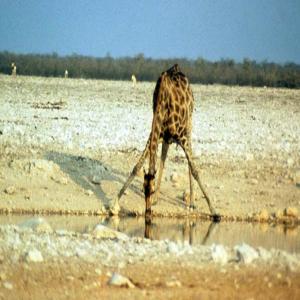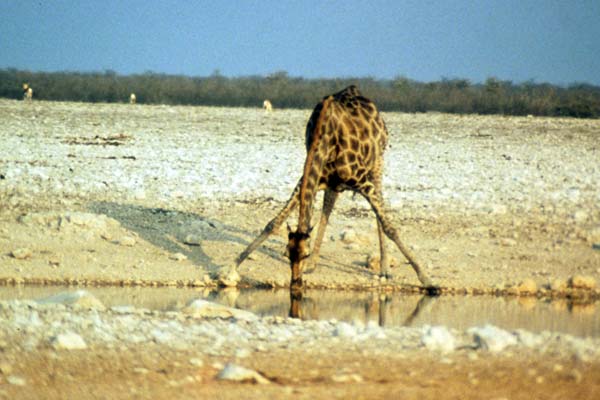Episodes

Monday Aug 15, 2011
The WildLife: Commercial Porcupine Farming in Vietnam, Emma Brooks
Monday Aug 15, 2011
Monday Aug 15, 2011
IUCN program officer Emma Brooks discusses illegal wildlife trade in Vietnam and her research on how commercial farming of a traded species, like porcupines, affects both the species and the trade. She tells “The WildLife” host Laurel Neme how most animals in Vietnam’s wildlife trade end up on the plates of wealthy restaurant patrons. In Vietnam and elsewhere, commercial wildlife farming, meaning the breeding of wild species for legal sale, is often promoted to supply demand while preventing overhunting in the wild. However, in a study on the conservation impact of commercial wildlife farming of porcupines in Vietnam published in August 2010 in Biological Conservation, IUCN program officer Emma Brooks concluded that commercial porcupine farming is instead having the opposite effect.
Emma Brooks has been involved with numerous conservation projects around the world, from biodiversity surveys in Mozambique to Giant River Otter counts in Bolivia. She first became interested in wildlife trade issues during her MSc at the University of East Anglia, UK. Her research in the trade in porcupines formed her dissertation topic, for which she spent three months collecting data and interviewing locals in northern Viet Nam. Emma now works for the IUCN, as part of the Global Species Programme based in Cambridge, UK. Her work includes assessing the extinction risk of species from around the world for inclusion on the IUCN Red List of Threatened Species, as well as using the information gathered to analyze species richness, major species and habitat threats, and important areas for biodiversity. The importance of species, ecosystems and services to human livelihoods and wellbeing is increasingly being recognized, and she works in a number of areas to provide the information to support decisions for the protection of species and livelihoods. This episode of “The WildLife” was posted on August 15, 2011.
The WildLife is a show that explores the mysteries of the animal world through interviews with scientists, authors and other wildlife investigators. It airs every Monday from 1-2 pm EST on The Radiator, WOMM-LP, 105.9 FM in Burlington, Vermont.
Monday Jun 20, 2011
The WildLife: Bear Bile Trade in Asia, Kaitlyn Foley
Monday Jun 20, 2011
Monday Jun 20, 2011
Kaitlyn Foley, senior programme officer at TRAFFIC Southeast Asia, talks about the bear bile trade in Asia. She tells “The WildLife” host Laurel Neme how recent research by TRAFFIC shows that the illegal bear bile trade continues unabated across Asia on a large scale.
The poaching and illegal trade of bears is driven largely by the demand for their bile, which is used in traditional medicine and folk remedies. Research by TRAFFIC, published in the report Pills, Powders, Vials & Flakes: The bear bile trade in Asia, found bear bile products on sale in traditional medicine outlets in all but one (Macao) of the 13 countries/territories surveyed, suggesting a complex and robust trade in bear products. Of particular note were mainland China, Hong Kong, Malaysia, Myanmar and Viet Nam, where bear bile products were most frequently observed. While bile from bear farms in China is legal if sold domestically, TRAFFIC found this Chinese bear bile being illegal sold across the border. It also noted that “Mom & Pop” bear farms were popping up in Laos and Myanmar, making these countries new potential hubs for this trade.
Kaitlyn-Elizabeth Foley is a senior programme officer at TRAFFIC Southeast Asia. She holds a BA in Anthropology from the University of Rhode Island and a Master of Science in Primate Conservation from Oxford Brookes University. Her main research interests include wildlife trade, conservation, and animal behavior and welfare. For the past nine years, Kaitlyn has lived and worked abroad in Italy, the United Kingdom and Malaysia. Most recently her work and research interest has been focused on the conservation and mitigation of trade in bears and the pet trade of mammals in Asia. This episode of “The WildLife” aired on The Radiator, WOMM-LP, 105.9 FM in Burlington, Vermont on June 20, 2011.

Monday Mar 14, 2011
The WildLife: The Dark Side of New Species Discovery, Bryan Stuart
Monday Mar 14, 2011
Monday Mar 14, 2011
Bryan Stuart, curator of amphibians and reptiles at the North Carolina Museum of Natural Sciences, talks about the dark side of the discovery of new species. He tells “The WildLife” host Laurel Neme about his experience following his scientific discovery in Laos of a warty salamander (Paramesotriton laoensis) with striking markings. Shortly after describing the previously unknown species in a scientific paper published in 2002, commercial dealers began collecting the salamanders for sale into the pet trade. Particularly galling to Bryan was the fact that they used his geographic description as a roadmap to find the rare newt. This situation is not unique. It’s also happened with a turtle (Chelodina mccordi) from the small Indonesian island of Roti, which so heavily hunted that today it is nearly extinct in the wild. Similarly, a rare gecko (Goniurosaurus luii) from southeastern China was extirpated from its locality as prices in importing countries soared to highs of $1,500 to $2,000 each. It’s a dual dilemma. On the one hand, publishing new species descriptions may inadvertently facilitate their extinctions for commercially valuable species, yet on the other, the conservation benefits of describing the new species can outweigh this potential risk. Bryan recommends that taxonomists work closely with relevant governmental agencies to coordinate publication of the description with legislation or management plans that thwart overexploitation of the new species. In fact, Bryan and his students have worked tirelessly in this regard and, in August 2008, Laos’ Department of Forestry protected this salamander from commercial trade. Now the remaining question is enforcement. Note: Laurel first met Bryan while researching a wildlife trafficking case for ABC News Nightline that involved the illegal import of hundreds of these rare salamanders that were dried and destined for traditional medicine.
Bryan Stuart is curator of amphibians and reptiles at the North Carolina Museum of Natural Sciences. He received his Bachelor of Science (B.Sc.) in biology from Cornell University, a Master of Science (M.Sc.) in zoology from North Carolina State University, and a Ph.D. in biology from the University of Illinois. He also held a post-doctoral appointment at the Museum of Vertebrate Zoology at the University of California, Berkeley, before returning to Raleigh to join the North Carolina Museum of Natural Sciences in September 2008. His research interests are in the biodiversity, systematics, biogeography and conservation of amphibians and reptiles. Much of his research has focused on amphibians and reptiles of the Old World tropics, especially Southeast Asia, where he has maintained an active field program for the past decade. He has particular interest in using molecular tools to define species boundaries and unravel their evolutionary histories. This episode of “The WildLife” aired on The Radiator, WOMM-LP, 105.9 FM in Burlington, Vermont on March 14, 2011.

Monday Nov 01, 2010
The WildLife: Life of a Wildlife Special Agent, Sheila O'Connor
Monday Nov 01, 2010
Monday Nov 01, 2010
US Fish and Wildlife Service Special Agent Sheila O’Connor reveals what it’s like to work in wildlife law enforcement. In the first of a two-part interview, Special Agent O’Connor tells “The WildLife” host Laurel Neme about her adventures stopping wildlife crime—from tarantulas to elephants. (Part 2 next week will focus on what it takes to be a special agent and the specialized training officers go through.)
Special Agent O’Connor is a veteran wildlife law enforcement officer, with over 20 years of service under belt. She began her career in wildlife law enforcement as a Conservation Police Officer for the Illinois Department of Natural Resources, where she served for eight years. She then moved to federal wildlife law enforcement with the US Fish and Wildlife Service, where she was first posted to Ann Arbor, Michigan, and then to St. Paul, Minnesota. During that time, she investigated several cases that led to felony convictions for violations of wildlife laws. She was recently promoted to be a training officer at the Federal Law Enforcement Training Center (also known as FLETC) in Georgia. This episode of “The WildLife” aired on The Radiator, WOMM-LP, 105.9 FM in Burlington, Vermont on November 1, 2010.

Monday Sep 13, 2010
The WildLife: Lorises, Anna Nekaris
Monday Sep 13, 2010
Monday Sep 13, 2010
Anna Nekaris, an expert on nocturnal primates, discusses Asia’s slow and slender lorises. She reveals to “The WildLife” host Laurel Neme what makes these creatures so special and why they’re sought after both as pets and as a key ingredient in traditional medicine. Did you know that the lovable, furry Ewoks in Star Wars films were modeled after slow lorises? But unlike Ewoks, lorises can’t jump or leap, which means they can only move through the forest canopy by using branches that touch.That makes an intact forest vital to their survival. Lorises are also one of the only venomous primates. They have a form of biological venom that’s produced by a gland in their elbows, which they mix with saliva to create a powerful toxin. These unique characteristics are what make them a sought after ingredient in traditional medicine across Asia. In fact, Anna and her research team recently completed the first major study of the use of lorises in traditional medicine in Asia and found a multitude of uses -- as a tonic for women after childbirth, for stomach problems, for healing wounds and broken bones, and in the treatment of sexually transmitted diseases. Lorises are seen as “an animal with 100 uses,” akin to aspirin in Western medicine. Anna Nekaris is a Reader and Course Tutor in Primate Conservation at Oxford Brookes University in the United Kingdom. She is also a member of the IUCN/SSC Primates Specialist Group, the Conservation Working Party of the Primate Society of Great Britain, and on the editorial board of Endangered Species Research and Folia Primatologica. Anna’s main research interests fall under the areas conservation, ecology, and speciation, with her fieldwork taking her to Trinidad, Senegal, Utah, India, Sri Lanka, Singapore, Indonesia, Uganda and Kenya. Although she has conducted fieldwork on bats, small carnivores (including civets and cats), mouse deer, and giant squirrels, her primary research focus is on primates. She has conducted many long-term studies of Indian and Sri Lankan slender lorises. Her current research project, on the diversity and conservation of Asian slow lorises, is being undertaken by Anna and postgraduate students in Java, Sumatra, Thailand, Cambodia, Laos, Singapore and Malaysia, where at least five species of slow loris are found. The team is using morphological, behavioral and vocal analyses to uncover diversity within this group. She has written several articles on the loris trade, including in Endangered Species Research and the American Journal of Primatology, contributed an article on the Javan slow loris to the IUCN/SSC Primate Specialist Groups Top 25 Most Endangered Primates, written a book that includes myths and legends on slender lorises, and contributes to the Loris Potto Conservation Database. This episode of “The WildLife” aired on The Radiator, WOMM-LP, 105.9 FM in Burlington, Vermont on September 13, 2010.

